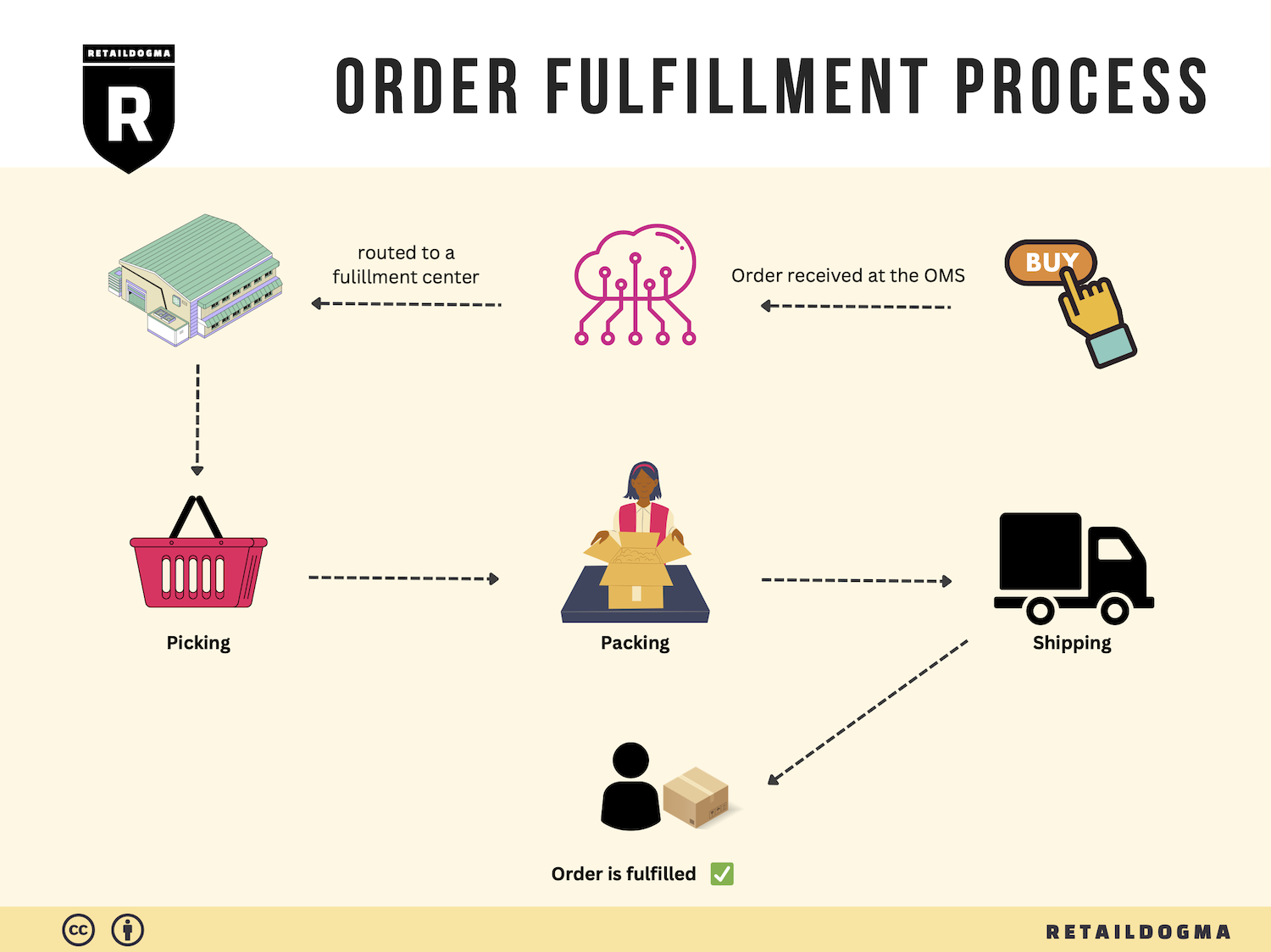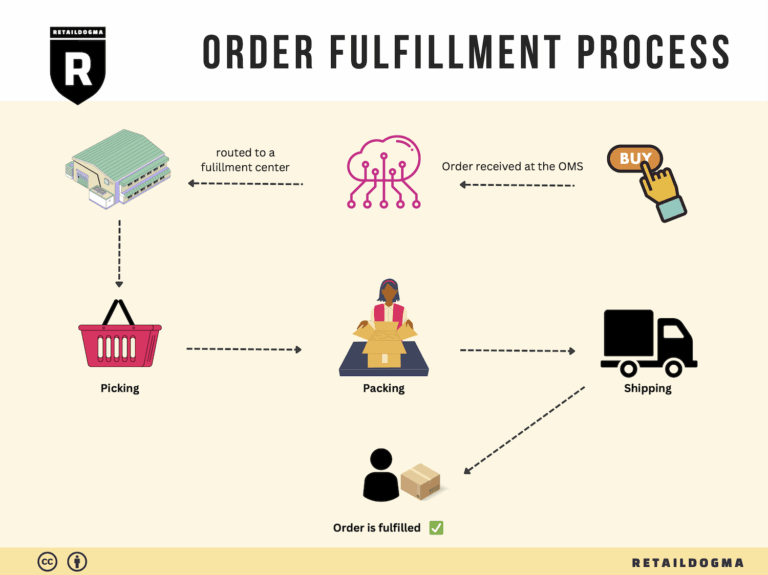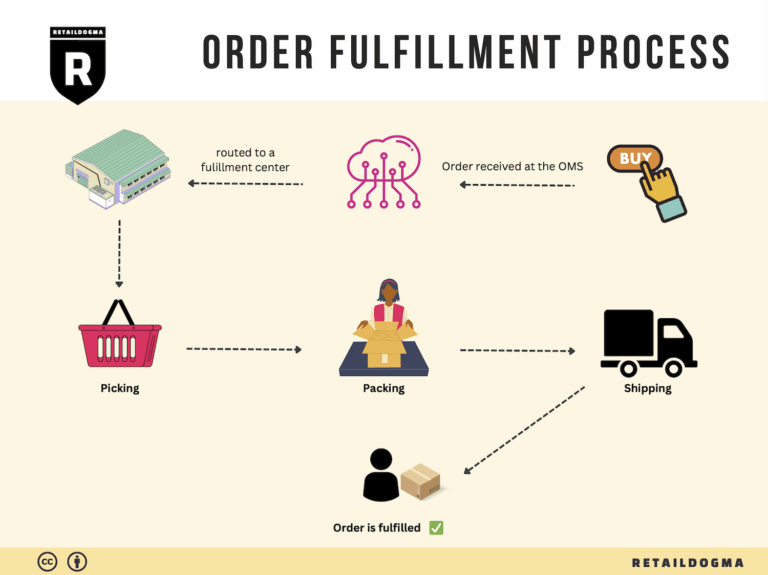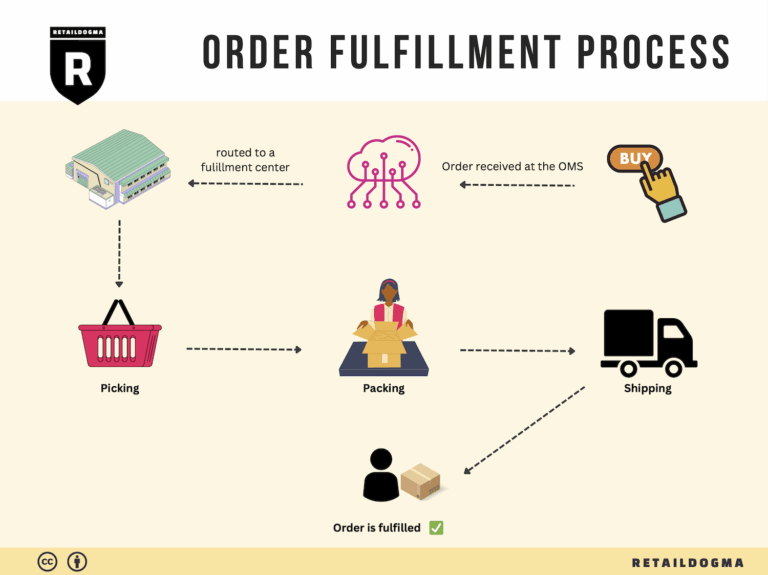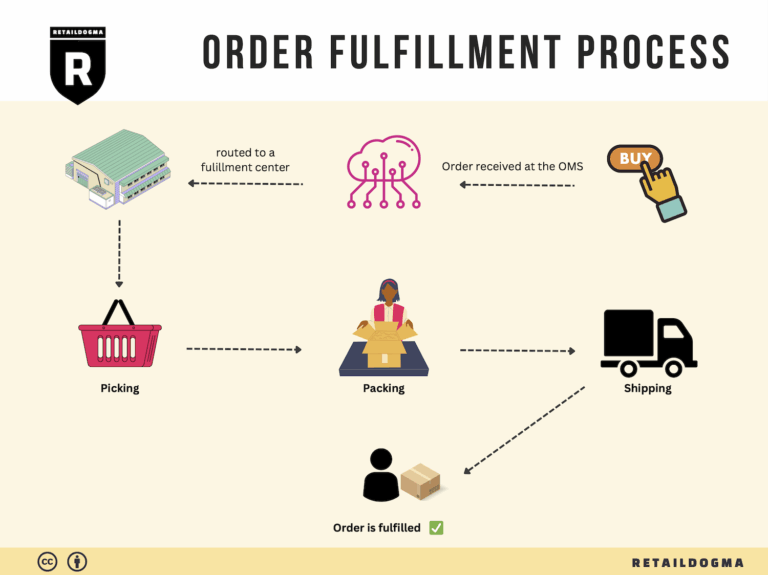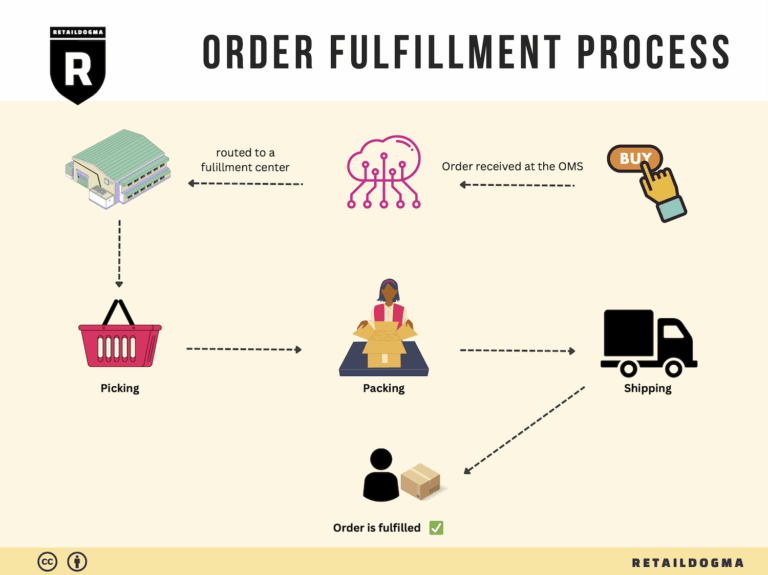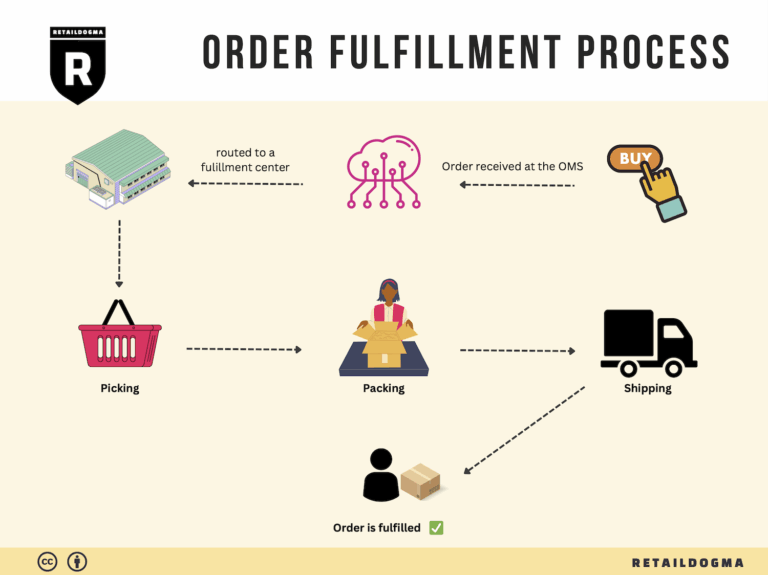What Is A Fulfillment Center? A Complete Guide (2025)
What is E-commerce Fulfillment? An Introduction for Growing Businesses
Understanding E-commerce Fulfillment
As an e-commerce business owner, one of the most common challenges you may face is managing the overwhelming tasks associated with packing and shipping orders. This crucial aspect of your operations can quickly become a bottleneck, consuming time and resources that could be better spent on growing your business. E-commerce fulfillment is the process of getting a product from your inventory to your customer’s doorstep, and it encompasses everything from order processing to shipping and returns management.
In this guide, we will delve into the various models of fulfillment available to growing businesses. Whether you are considering a third-party logistics (3PL) provider or utilizing Fulfillment by Amazon (FBA), understanding the differences between these options is essential for making informed decisions. Each model comes with its unique advantages and challenges, and selecting the right one can significantly impact your operational efficiency and customer satisfaction.
We will also explore the core services involved in e-commerce fulfillment. This includes inventory management, order processing, packing, shipping, and handling returns. Each service plays a vital role in ensuring that your customers receive their orders accurately and on time. By understanding these services, you can better evaluate potential fulfillment partners and their capabilities.
Choosing the right fulfillment partner is a critical decision that can affect your business’s scalability and profitability. We will provide practical insights on what to consider when evaluating potential partners, including their technology, service levels, and geographical reach. It’s essential to align your fulfillment strategy with your business goals to ensure a seamless flow of products to your customers.
Lastly, we will discuss pricing models in the fulfillment landscape. Understanding the cost structures associated with different fulfillment options will empower you to make financial decisions that support your business’s growth while maintaining competitive pricing for your customers.
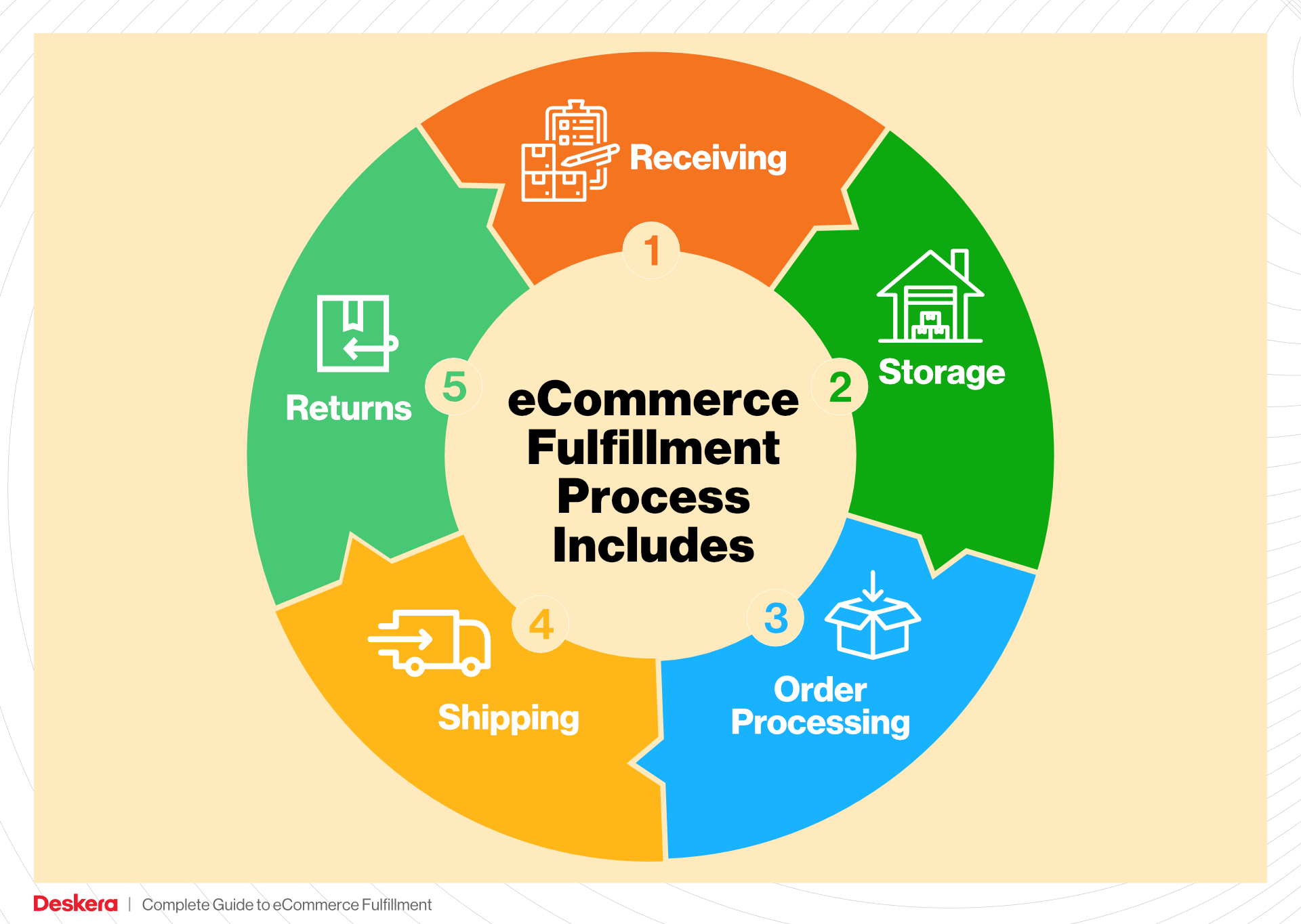
The ultimate goal of this guide is to equip you with the knowledge and tools necessary to make smart decisions about your logistics strategy. By taking a proactive approach to e-commerce fulfillment, you can alleviate operational burdens, enhance customer satisfaction, and set your business up for sustainable growth.
What You’ll Learn In This Guide
- What is E-commerce Fulfillment? An Introduction for Growing Businesses
- The Order Fulfillment Process: From ‘Buy’ Button to Customer’s Door
- Comparing Fulfillment Models: In-House vs. 3PL vs. Dropshipping
- A Deep Dive into Amazon FBA: Pros, Cons, and Who It’s For
- Core Services Offered by Fulfillment Centers
- How to Choose a Fulfillment Partner: A 6-Point Checklist
- Understanding Fulfillment Pricing: A Breakdown of Common Fees
- Frequently Asked Questions (FAQs) about Fulfillment
- Conclusion: Is Outsourcing Fulfillment the Right Move for Your Business?
- Important Disclaimer
The Order Fulfillment Process: From ‘Buy’ Button to Customer’s Door
1. Receiving Inventory
The first step in the order fulfillment process is receiving inventory, where products are delivered to the fulfillment center from suppliers or manufacturers. This stage is crucial as it sets the foundation for efficient order processing. Upon arrival, each shipment is checked against the purchase order to ensure accuracy, which involves verifying quantities and inspecting for damage.
Key Term: SKU (Stock Keeping Unit)
Each product is assigned a unique SKU, which aids in tracking inventory levels and locations within the warehouse. Effective inventory management during the receiving stage helps prevent stock discrepancies and ensures that products are available for order fulfillment.
2. Warehouse Storage
Once inventory is received and verified, the next step is warehouse storage. Products are organized and stored in designated areas of the fulfillment center based on various factors such as size, type, and demand. Proper storage solutions enhance accessibility and optimize space, which is vital for maintaining an efficient workflow.
Key Term: Bin Location
Each item is assigned a specific bin location, which is logged in the warehouse management system (WMS). This system allows for quick retrieval of products and minimizes the time spent searching for items, ultimately improving overall efficiency in order processing.
3. Order Picking
After a customer places an order, the picking process begins. This involves retrieving the ordered items from their respective storage locations within the warehouse. Speed and accuracy are paramount in this stage, as errors can lead to customer dissatisfaction and increased return rates.
Key Term: Pick Lists
Pick lists are generated from the order details and guide warehouse staff to the exact locations of each product needed for fulfillment. Utilizing advanced picking methods—such as batch picking or zone picking—can streamline this process, allowing multiple orders to be picked simultaneously, thereby increasing throughput.
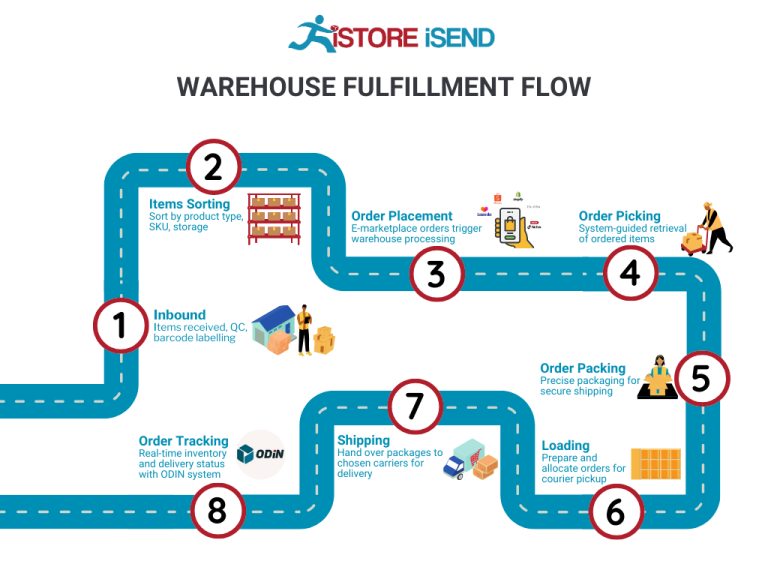
4. Order Packing
Once items are picked, they move to the packing station, where they are prepared for shipping. This involves placing the products in appropriate packaging materials to ensure they are protected during transit. Effective packing not only safeguards items but also reflects the brand’s commitment to quality.
Key Term: Packing Slip
A packing slip is included with each order, detailing the items enclosed and serving as a confirmation for both the customer and the fulfillment center. Proper packing techniques, including the use of cushioning materials and appropriate box sizes, can significantly reduce the risk of damage during shipping, enhancing customer satisfaction.
5. Shipping & Delivery
The final step in the fulfillment process is shipping and delivery. Once orders are packed, they are labeled and sorted based on their destination. Efficient logistics partnerships with carriers are essential for ensuring timely delivery to customers.
Key Term: Last-Mile Delivery
This term refers to the final leg of the delivery journey, where packages are transported from a distribution center to the end customer’s location. Optimizing last-mile delivery is crucial, as it directly impacts customer experience and can differentiate your business in a competitive market. Utilizing advanced tracking systems allows customers to monitor their orders in real-time, enhancing transparency and trust.
Conclusion
Understanding the order fulfillment process is essential for e-commerce businesses looking to scale their operations. Each step—from receiving inventory to shipping and delivery—plays a pivotal role in ensuring that customers receive their orders accurately and on time. By implementing best practices and leveraging key terms like SKU, bin location, pick lists, packing slips, and last-mile delivery, businesses can enhance their efficiency and improve customer satisfaction, paving the way for growth and success in the competitive e-commerce landscape.

Comparing Fulfillment Models: In-House vs. 3PL vs. Dropshipping
Fulfillment Model Comparison
| Model | Who Handles Inventory | Best For (Business Stage) | Key Advantage | Key Disadvantage |
|---|---|---|---|---|
| In-House Fulfillment | Business itself | Established businesses | Full control over operations | High overhead and fixed costs |
| Third-Party Logistics (3PL) | Third-party provider | Growing businesses | Scalability and expertise | Less control over inventory |
| Dropshipping | Supplier | Startups and small businesses | Low startup costs | Lower profit margins and dependency |
In-House Fulfillment
In-house fulfillment involves managing all aspects of inventory and order processing within the business itself. This model is typically favored by established businesses that have the resources to maintain a dedicated warehouse and logistics team. The primary advantage of in-house fulfillment is the complete control it provides over inventory management, order accuracy, and customer service. Businesses can customize their operations to fit specific needs, ensuring that they meet customer expectations effectively.
However, this model also has significant downsides. The overhead costs associated with warehousing, staffing, and logistics can be substantial, leading to a higher break-even point. Additionally, businesses may face challenges with scalability; as order volumes increase, they must invest in additional resources, which can strain cash flow. In-house fulfillment is best suited for companies that have a stable demand and can justify the investment in infrastructure.
Third-Party Logistics (3PL)
Third-party logistics (3PL) involves outsourcing logistics operations to specialized providers. This model is ideal for growing businesses that want to scale quickly without the burden of managing their own fulfillment centers. 3PL providers offer a wide range of services, including warehousing, inventory management, and shipping, allowing businesses to focus on their core competencies, such as sales and marketing.
One of the key advantages of using a 3PL provider is the scalability it offers. As a business grows, its logistics partner can adjust services to match demand, reducing the risk of over- or under-investing in fulfillment capabilities. Additionally, many 3PL providers have established relationships with shipping carriers, which can lead to lower shipping costs and improved delivery times.
However, outsourcing logistics does come with some disadvantages. Businesses may find themselves with less control over inventory and fulfillment processes, potentially leading to inconsistencies in customer service. Furthermore, the quality of service can vary significantly between 3PL providers, making it crucial for businesses to conduct thorough due diligence before choosing a partner.
Dropshipping
Dropshipping is a fulfillment model where the retailer does not hold any inventory. Instead, when a customer places an order, the retailer purchases the item from a third party (usually a supplier or manufacturer) who ships it directly to the customer. This model is especially appealing to startups and small businesses, as it requires minimal upfront investment and eliminates the need for warehousing.
The primary advantage of dropshipping is its low startup costs. Entrepreneurs can launch an e-commerce store without the financial burden of purchasing inventory upfront. This model also allows for a wide product range without the risk of unsold inventory, making it easier to test new products and market trends.
However, dropshipping has its drawbacks. The most significant challenge is the lower profit margins compared to traditional retail models, as suppliers often take a substantial cut of the sale price. Additionally, retailers have limited control over inventory levels and shipping times, which can result in inconsistent customer experiences. Entrepreneurs must also navigate the complexities of supplier relationships and ensure that they are working with reliable partners to avoid fulfillment issues.
Conclusion
Choosing the right fulfillment model is crucial for the success of an e-commerce business. Each model—In-House Fulfillment, Third-Party Logistics (3PL), and Dropshipping—offers unique advantages and disadvantages that can significantly impact operations and profitability. Established businesses may find in-house fulfillment beneficial for maintaining control, while growing companies often leverage 3PL to scale efficiently. Startups may prefer the low barrier to entry that dropshipping provides. Understanding these dynamics allows business owners to align their fulfillment strategy with their growth objectives and operational capabilities.
A Deep Dive into Amazon FBA: Pros, Cons, and Who It’s For
Understanding Fulfillment by Amazon (FBA)
Fulfillment by Amazon (FBA) is a service that allows e-commerce sellers to store their products in Amazon’s fulfillment centers. Amazon then takes care of storage, packaging, and shipping, as well as customer service and returns. This service enables sellers to leverage Amazon’s vast logistics network and customer base, significantly simplifying the process of selling online.
How FBA Works
-
Product Preparation: Sellers prepare their products according to Amazon’s guidelines, including labeling and packaging requirements. This ensures that items are ready for storage and shipment once they arrive at the fulfillment center.
-
Shipping to Amazon: Sellers send their products to one or more of Amazon’s fulfillment centers. The location you choose may depend on your target market and shipping preferences.
-
Storage: Once products are received at the fulfillment center, they are stored until a customer places an order. Amazon manages inventory levels and organizes the products for efficient picking and packing.
-
Order Fulfillment: When a customer places an order, Amazon picks the product from the warehouse, packages it, and ships it directly to the customer. This process is typically quick, with many orders being shipped within the same day.
-
Customer Service: Amazon handles all customer inquiries and returns related to FBA products. This includes managing refunds and exchanges, allowing sellers to focus on other aspects of their business.
-
Payment: After the sale, Amazon processes the payment and deposits the seller’s earnings into their account, minus applicable fees.
Pros of Using FBA
-
Prime Eligibility: Products fulfilled by Amazon are eligible for Amazon Prime, which can significantly increase visibility and sales. Prime members often prefer products that come with free two-day shipping, making FBA a key advantage for sellers.
-
Customer Trust: Leveraging Amazon’s brand reputation can build customer trust. Many shoppers feel more comfortable purchasing products that are fulfilled by Amazon, knowing that they will receive reliable service and support.
-
Multi-Channel Fulfillment: FBA is not limited to sales on Amazon. Sellers can use FBA to fulfill orders from other sales channels, such as their own websites or other marketplaces, allowing for streamlined logistics across various platforms.
-
Scalability: FBA allows sellers to scale their business rapidly without needing to invest in their own warehousing or logistics infrastructure. This is particularly beneficial for small to medium-sized businesses looking to grow.
-
Time Savings: By outsourcing storage, packing, and shipping to Amazon, sellers can save time and focus on marketing, product development, and other strategic areas of their business.
Cons of Using FBA
-
High Fees: FBA comes with various fees, including storage fees (charged monthly based on the amount of space your inventory takes) and fulfillment fees (charged per unit sold). These costs can add up, especially for sellers with low-margin products.
-
Strict Inventory Rules: Amazon has stringent policies regarding inventory management. Sellers must adhere to guidelines for storage limits and product condition, which can be challenging for those with fluctuating inventory levels.
-
Commingling Risks: Amazon uses a commingling strategy, where inventory from different sellers is stored together. This can lead to issues if a seller receives returns or negative feedback due to another seller’s products. While Amazon does have safeguards, this risk can be concerning for some sellers.
-
Loss of Control: By using FBA, sellers relinquish some control over the fulfillment process. This includes aspects like packaging and customer interaction, which can affect brand experience.
-
Complex Returns Management: While Amazon handles returns for FBA sellers, this can sometimes result in lost inventory without proper tracking. Sellers may find it challenging to manage returns and account for discrepancies.
Who is FBA Best For?
Fulfillment by Amazon is ideally suited for:
-
Small to Medium-Sized Businesses: Companies that want to scale their operations quickly without investing heavily in logistics infrastructure can benefit significantly from FBA.
-
E-commerce Entrepreneurs: New sellers looking to enter the market can leverage FBA to access Amazon’s vast customer base and logistics capabilities, making it easier to launch and grow their brand.
-
Brands Seeking Prime Access: Sellers who aim to target Prime members and want their products to stand out with fast shipping options will find FBA an essential tool.
-
Multi-Channel Sellers: Businesses that sell across various platforms can use FBA to streamline their fulfillment process, allowing them to maintain consistent inventory management and customer service across all channels.
In conclusion, while Fulfillment by Amazon presents several advantages that can help businesses scale efficiently, it also comes with challenges that require careful consideration. E-commerce business owners must weigh these pros and cons based on their unique operational needs and market strategies to determine if FBA is the right fit for their business model.
Core Services Offered by Fulfillment Centers
Inventory Management & Warehousing
Inventory management is a critical function of fulfillment centers that involves tracking and controlling stock levels, ensuring that products are available when needed without overstocking. Fulfillment centers like MDW4 in Joliet, IL, provide advanced inventory management systems that utilize real-time data to optimize stock levels and minimize carrying costs.
Benefits:
1. Enhanced Visibility: E-commerce businesses gain access to real-time inventory data, enabling them to make informed decisions about stock replenishment and avoid stockouts or overstock situations.
2. Cost Efficiency: By leveraging a fulfillment center’s warehousing capabilities, businesses can reduce the costs associated with maintaining their own storage facilities. This leads to significant savings on rent, utilities, and labor.
3. Scalability: As businesses grow, fulfillment centers can easily accommodate increased inventory levels without the need for substantial upfront investments in additional warehousing space.
Pick and Pack Services
Pick and pack services refer to the process of selecting items from inventory (picking) and packaging them for shipment (packing). Fulfillment centers streamline this process, ensuring that orders are fulfilled accurately and efficiently. At MDW4, for instance, advanced technology and trained staff work together to ensure that orders are processed quickly.
Benefits:
1. Speed and Accuracy: Fulfillment centers employ sophisticated systems that minimize human error and expedite the picking process, leading to faster order fulfillment and improved customer satisfaction.
2. Customization: Businesses can offer personalized packaging options to enhance customer experience, such as including gift messages or branded materials, which can be managed easily through fulfillment services.
3. Focus on Core Activities: By outsourcing pick and pack operations, e-commerce businesses can concentrate on other critical areas such as marketing, product development, and customer service, ultimately driving growth.
Kitting and Assembly
Kitting and assembly services involve combining multiple products into a single package or kit, which can be particularly useful for promotional items or bundled offers. Fulfillment centers like MDW4 can handle complex kitting tasks that require precision and efficiency.
Benefits:
1. Streamlined Operations: By outsourcing kitting and assembly, businesses can simplify their operations, reducing the need for in-house labor dedicated to these tasks.
2. Improved Product Offerings: Kitting allows businesses to create unique product bundles that can attract customers and increase average order value. This flexibility can be a significant competitive advantage.
3. Quality Control: Fulfillment centers often have quality assurance processes in place, ensuring that kits are assembled correctly and meet customer expectations before they are shipped.
Returns Management (Reverse Logistics)
Returns management, or reverse logistics, is the process of handling returned products and managing the associated logistics. Fulfillment centers play a crucial role in streamlining this process, helping businesses efficiently manage returns while minimizing costs.
Benefits:
1. Customer Satisfaction: A well-managed returns process can significantly enhance customer experience. Fulfillment centers provide quick and efficient processing of returns, ensuring customers receive timely refunds or exchanges.
2. Cost Reduction: By centralizing returns management, fulfillment centers can reduce the costs associated with handling returns. They can inspect, restock, or dispose of returned items more efficiently than most e-commerce businesses could on their own.
3. Data Insights: Fulfillment centers can provide valuable analytics on return trends, helping businesses identify common reasons for returns and enabling them to make informed decisions to improve product quality or customer satisfaction.
Conclusion
Choosing the right fulfillment center, such as MDW4 in Joliet, IL, can provide e-commerce businesses with a competitive edge by offering essential services that streamline operations and enhance customer satisfaction. From inventory management and pick and pack services to kitting and returns management, these core services enable businesses to scale efficiently while focusing on their primary objectives. By leveraging the expertise and resources of fulfillment centers, e-commerce entrepreneurs can optimize their logistics, reduce costs, and ultimately drive growth.
How to Choose a Fulfillment Partner: A 6-Point Checklist
Location & Warehouse Network
When selecting a fulfillment partner, the geographic location of their warehouses is paramount. A partner with strategically located facilities can significantly reduce shipping times and costs, particularly for businesses that operate nationally or internationally.
Why It’s Important:
Proximity to key markets can enhance customer satisfaction through faster delivery, which is increasingly expected in the e-commerce landscape. Moreover, a wide network of warehouses allows for efficient inventory management and distribution strategies.
Questions to Ask:
– Where are your warehouses located, and how does this impact shipping times to my customer base?
– Do you have multiple locations to facilitate quicker deliveries across different regions?
– How do you handle inventory across different warehouses?
Technology & Integrations
The technology stack of your fulfillment partner plays a crucial role in ensuring seamless operations. Look for partners that provide robust software solutions for inventory management, order processing, and shipping.
Why It’s Important:
Advanced technology enables real-time tracking, automation of various processes, and integration with your existing e-commerce platforms (e.g., Shopify, Amazon, eBay). A partner who utilizes the latest technology can enhance efficiency and accuracy, reducing the risk of errors.
Questions to Ask:
– What technology do you use for inventory management and order processing?
– Can your systems integrate with my existing e-commerce platform and other tools I use (e.g., accounting, CRM)?
– Do you offer real-time tracking and reporting for shipments?
Specializations (e.g., Cold Storage, Oversized Items)
Different businesses have unique needs, and some fulfillment partners specialize in specific areas such as cold storage, hazardous materials, or oversized items. Understanding these specializations can help you find a partner that meets your specific requirements.
Why It’s Important:
Choosing a partner that specializes in the type of products you sell can lead to more efficient handling, storage, and shipping processes. This is particularly crucial for businesses dealing with sensitive goods, like perishables or fragile items.
Questions to Ask:
– Do you have experience handling products similar to mine?
– What specialized services do you offer, such as temperature control or handling oversized items?
– Can you accommodate any unique packaging or shipping requirements for my products?
Scalability & Capacity
As your business grows, your fulfillment needs will evolve. A partner’s ability to scale their operations in line with your growth is essential.
Why It’s Important:
A partner that can easily adjust to increasing order volumes or seasonal fluctuations will save you time and resources. You want to ensure they can accommodate your growth without compromising service quality.
Questions to Ask:
– How do you handle seasonal spikes in order volume?
– What is your capacity for handling increased order volumes?
– Can you provide case studies or examples of how you’ve scaled for other clients?
Pricing and Contracts
Understanding the pricing structure and contract terms is crucial to avoid unexpected costs and ensure that the partnership remains financially viable.
Why It’s Important:
Transparent pricing helps you budget effectively and avoid hidden fees that can eat into your margins. Additionally, favorable contract terms can provide flexibility as your business needs change.
Questions to Ask:
– Can you provide a detailed breakdown of your pricing structure?
– Are there any additional fees for services like storage, packing, or returns?
– What are the contract terms, and is there flexibility to adjust if my needs change?
Customer Support & Reviews
The level of customer support provided by your fulfillment partner can significantly impact your operational efficiency. Additionally, researching reviews and testimonials can give you insight into their reliability and service quality.
Why It’s Important:
Effective customer support ensures that any issues can be resolved quickly, minimizing disruptions to your operations. Positive reviews from other businesses indicate a partner’s reliability and commitment to service.
Questions to Ask:
– What type of customer support do you offer (e.g., dedicated account manager, 24/7 support)?
– How do you handle issues or disputes that may arise?
– Can you provide references or case studies from similar businesses you’ve worked with?
Conclusion
Choosing the right fulfillment partner is a critical decision that can influence your business’s scalability, efficiency, and customer satisfaction. By considering these six key factors—Location & Warehouse Network, Technology & Integrations, Specializations, Scalability & Capacity, Pricing and Contracts, and Customer Support & Reviews—you can make a more informed choice. Taking the time to ask the right questions will help ensure that your selected partner aligns with your business goals and can support your growth effectively.
Understanding Fulfillment Pricing: A Breakdown of Common Fees
Initial Setup Fees
When engaging with a fulfillment center such as Amazon’s MDW4 in Joliet, IL, businesses may encounter initial setup fees. These fees are typically one-time charges associated with establishing your account, integrating your systems, and preparing your products for storage and distribution. Costs can vary based on the complexity of your operations and the specific services you require.
The calculation of initial setup fees often includes factors such as:
– Account Creation: Basic administrative fees for setting up your account.
– Integration Costs: Fees related to integrating your e-commerce platform with the fulfillment center’s software systems.
– Product Setup: Charges for entering product information, including SKUs, descriptions, and images.
To minimize these costs, it’s advisable to gather all necessary product information beforehand and ensure your e-commerce platform is compatible with the fulfillment center’s systems.
Receiving Fees
Receiving fees are charges incurred when the fulfillment center accepts your inventory. These fees cover the labor and equipment needed to unload, inspect, and store your products. At MDW4, receiving fees are typically calculated on a per-unit basis, meaning that the more items you send, the higher your total fees will be.
Key components of receiving fees include:
– Inspection: Checking products for damage and ensuring they meet quality standards.
– Sorting and Storing: Organizing received items into the correct storage locations.
To reduce receiving fees, consider consolidating shipments and ensuring that your products are packed efficiently to minimize handling time.
Storage Fees (per pallet/bin)
Storage fees are recurring charges for the space your inventory occupies within the fulfillment center. MDW4, like many other fulfillment centers, typically charges these fees on a per-pallet or per-bin basis. This fee structure incentivizes businesses to optimize their inventory levels, as higher storage volumes lead to increased costs.
Storage fees can be influenced by:
– Seasonality: During peak seasons, such as holidays, storage fees may increase due to higher demand for space.
– Duration: Fees may vary based on how long your products remain in storage. Longer storage times often incur higher rates.
To manage storage costs effectively, analyze your inventory turnover rates and consider implementing just-in-time inventory practices to minimize the amount of product stored at any given time.
Pick & Pack Fees (per item/order)
Pick and pack fees are charged for the process of selecting products from storage and preparing them for shipment. At MDW4, these fees are usually calculated per item or per order, which can have significant implications for your overall fulfillment costs.
Factors affecting pick and pack fees include:
– Order Complexity: The more items in an order, the higher the fees due to the additional labor required.
– Packaging Requirements: Specialty packaging may incur additional charges.
To reduce pick and pack fees, streamline your product offerings to minimize complexity and encourage bulk orders from customers.
Shipping Fees
Shipping fees cover the cost of transporting your products from the fulfillment center to the customer. These fees can vary widely based on factors such as destination, shipping method (standard, expedited, etc.), and the weight of the package. MDW4 typically has established partnerships with various carriers, allowing for competitive shipping rates.
Considerations for calculating shipping fees include:
– Distance: Longer distances generally result in higher shipping costs.
– Weight and Dimensions: Heavier or larger packages may incur additional charges.
To optimize shipping costs, explore options for bulk shipping or negotiate rates with carriers if you have significant shipping volume.
Tips for Getting an Accurate Quote
To obtain an accurate quote for fulfillment services at MDW4 or any other fulfillment center, consider the following tips:
- Provide Detailed Information: Clearly outline your product dimensions, weights, and expected order volumes.
- Understand Fee Structures: Ask for a breakdown of all potential fees, including those that may not be immediately obvious.
- Inquire About Volume Discounts: Many fulfillment centers offer discounts for businesses with higher shipping volumes.
- Evaluate Your Needs: Assess your specific fulfillment needs, such as storage duration and order complexity, to get a tailored quote.
- Review Contract Terms: Understand the terms and conditions associated with the quote, including any penalties for underperformance or changes in your business model.
By following these strategies, you can effectively navigate fulfillment pricing and make informed decisions for your e-commerce operations.
Frequently Asked Questions (FAQs) about Fulfillment
1. What is the Amazon Fulfillment Center MDW4 located at Emerald Drive in Joliet, IL?
The Amazon Fulfillment Center MDW4, located at 201 Emerald Drive, Joliet, IL, is one of Amazon’s key distribution centers. It specializes in storing, picking, packing, and shipping a wide variety of products, including household essentials, luxury items, and gifts. This facility plays a crucial role in Amazon’s logistics network, ensuring efficient order fulfillment for customers across the United States.
2. How does the fulfillment process work at MDW4?
The fulfillment process at MDW4 involves several key steps:
1. Receiving: Products are delivered to the center and scanned into the inventory system.
2. Storage: Items are stored in designated areas, organized for efficient retrieval.
3. Picking: When an order is placed, items are picked from their locations.
4. Packing: Selected items are packed securely for shipment.
5. Shipping: Packed orders are sent out via various carriers to ensure timely delivery.
3. What are the benefits of using an Amazon Fulfillment Center like MDW4?
Utilizing an Amazon Fulfillment Center such as MDW4 offers several advantages:
– Speed: Orders are processed quickly due to the efficient logistics system.
– Scalability: Businesses can scale their operations without investing in their own warehousing and fulfillment infrastructure.
– Prime Eligibility: Products stored at MDW4 can be eligible for Amazon Prime, attracting more customers.
– Reduced Operational Burden: Businesses can focus on sales and marketing while Amazon handles storage, packing, and shipping.
4. What is the difference between a warehouse and a fulfillment center?
A warehouse is primarily used for storage of goods, often focusing on long-term inventory management. In contrast, a fulfillment center is designed for quick order processing and shipping. Fulfillment centers facilitate the entire order fulfillment process, including inventory management, picking, packing, and shipping, making them more dynamic and responsive to customer demands.
5. What is a 3PL (Third-Party Logistics) provider?
A 3PL (Third-Party Logistics) provider is a company that offers outsourced logistics services, including warehousing, fulfillment, and transportation. Businesses partner with 3PLs to leverage their expertise, technology, and infrastructure, allowing them to streamline operations and focus on core business activities. Amazon itself operates as a 3PL through its fulfillment centers, including MDW4.
6. How much do fulfillment services cost at MDW4?
Fulfillment service costs can vary significantly based on several factors, including:
– Storage Fees: Charged based on the volume of products stored.
– Fulfillment Fees: Based on the number of orders processed and items picked and packed.
– Shipping Costs: Determined by the destination and shipping method.
To get a precise estimate, businesses should consult Amazon’s pricing structure or contact their sales team for tailored quotes.
7. Can I send my products directly to the MDW4 fulfillment center?
Yes, businesses can send their products directly to the MDW4 fulfillment center. It is essential to follow Amazon’s guidelines for labeling and preparing products to ensure a smooth receiving process. Proper documentation and adherence to specifications will facilitate efficient inventory management and order fulfillment.
8. What types of products can be fulfilled at MDW4?
MDW4 can handle a wide range of products, including:
– Consumer Electronics
– Household Items
– Clothing and Accessories
– Health and Beauty Products
– Toys and Games
This versatility makes MDW4 a valuable asset for various e-commerce businesses.
9. How can I track my inventory stored at MDW4?
Businesses can track their inventory stored at MDW4 through the Amazon Seller Central platform. This online dashboard provides real-time updates on inventory levels, order statuses, and sales performance, allowing sellers to manage their stock efficiently and make informed decisions.
10. What support services are available for sellers using MDW4?
Sellers utilizing MDW4 can access a range of support services, including:
– Customer Service: Assistance with order inquiries, returns, and customer feedback.
– Technical Support: Help with integrating systems and troubleshooting issues.
– Training Resources: Guides and tutorials on best practices for inventory management and order fulfillment.
These services are designed to enhance the seller experience and ensure smooth operations.
Conclusion: Is Outsourcing Fulfillment the Right Move for Your Business?
Evaluating the Benefits of Outsourcing Fulfillment
Outsourcing fulfillment can be a transformative decision for e-commerce businesses looking to scale efficiently. One of the primary advantages is the significant time savings it offers. By delegating logistics to a specialized fulfillment partner, you free up valuable hours that can be redirected towards strategic initiatives such as marketing, product development, and customer engagement. This shift not only enhances productivity but also allows your team to focus on core competencies that drive growth.
Scalability is another compelling reason to consider outsourcing. As your business grows, so do the complexities of order management, inventory control, and shipping logistics. A fulfillment partner, particularly one with a robust infrastructure like the Amazon Fulfillment Center in Joliet, IL, can easily accommodate increased demand without the need for hefty investments in warehousing or staffing. This flexibility allows you to respond quickly to market changes and seasonal fluctuations, ensuring you can meet customer expectations consistently.
Moreover, partnering with a fulfillment service brings expertise that may not be available in-house. These providers have extensive experience in logistics, technology, and customer service, which can enhance your operational efficiency and improve the overall customer experience. Their insights can help you optimize your supply chain, reduce costs, and streamline processes.
However, it’s crucial to choose the right fulfillment partner to ensure your business’s growth trajectory aligns with their capabilities. Conducting a thorough audit of your current shipping and fulfillment processes is a strategic first step. Assess whether a fulfillment partner could enhance your efficiency and scalability. Don’t hesitate to explore your options; the right partnership could be the key to unlocking your business’s potential.
Important Disclaimer
⚠️ Important Disclaimer
The information in this guide is for educational purposes. Fulfillment services, pricing, and platform features change frequently. Always conduct your own due diligence and consult with providers directly before making business decisions.
